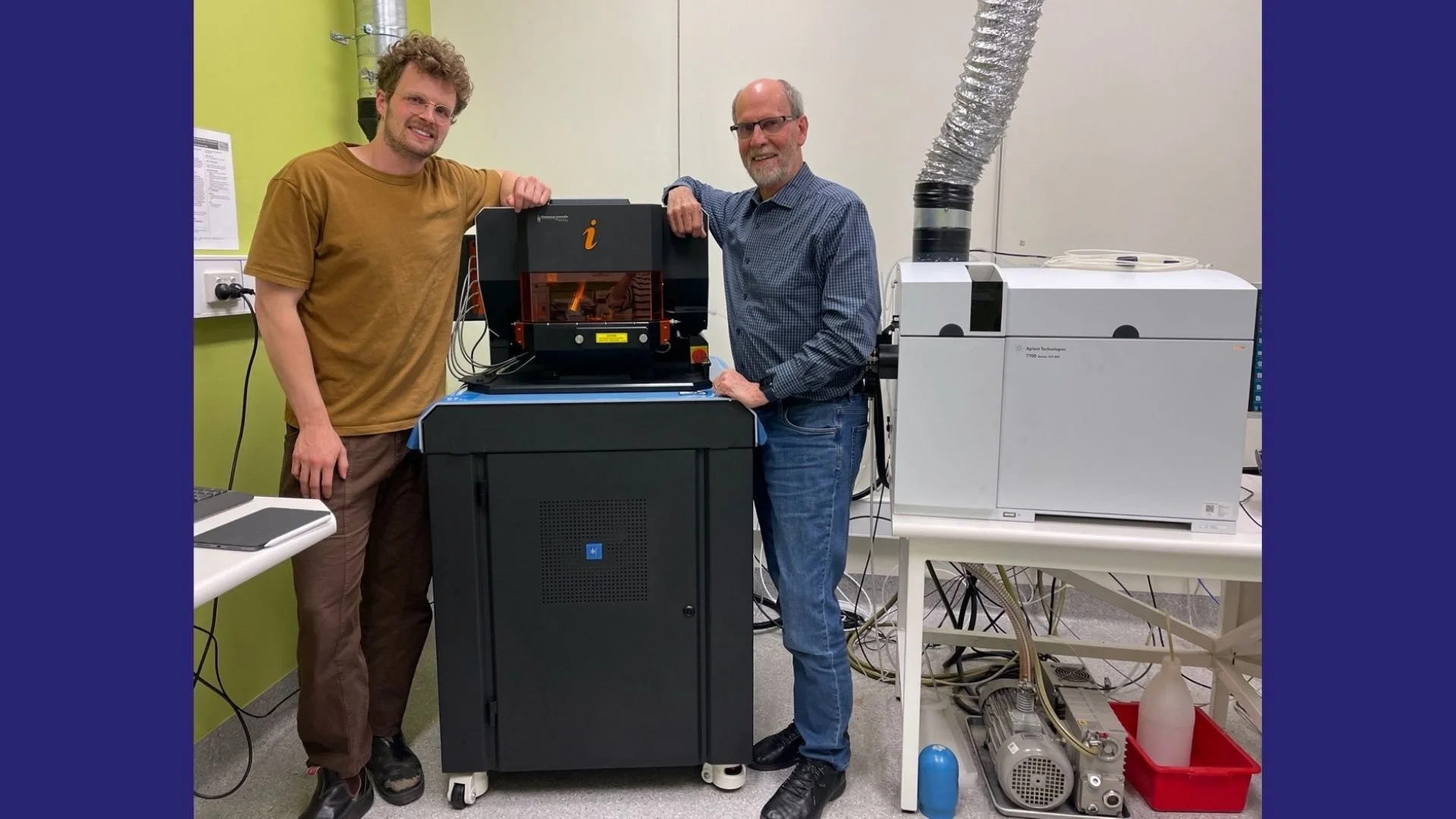Cutting-edge laser boosts thermochronology research at the University of Melbourne
Dr Malcolm MacMillan and Dr Ling Chung with ESL193 ImageGEO Laser System. Image: Melbourne Thermochronology Research Group AuScope edited.
Researchers from the University of Melbourne’s School of Geography, Earth and Atmospheric Sciences are transforming the speed and scale of their thermochronology research, enabling more effective and precise analysis of geological samples. The faster research is thanks to a new, state-of-the-art ESL193nm ImageGEO laser system from Elemental Scientific. The laser will accelerate earth science research in Australia.
Precision from the ground up
Thermochronology is a geological dating technique that reveals the time when rocks cooled below specific temperatures, often related to particular depths in the Earth’s crust. Unlike traditional geochronology, which determines the absolute age of rock formation, thermochronology reconstructs the thermal history of rocks by measuring the accumulation and retention of radioactive decay products or radiation damage in mineral grains, such as helium produced by the decay of uranium and thorium.
The team, including Emeritus Professor Andy Gleadow, and research fellows, Dr Ling Chung and Dr Malcolm McMillan are thrilled with how the new instrument will support their detailed work.
Andy said, “Geochronology is like seeing a birth certificate for somebody…whereas thermochronology is like writing their biography. It’s about what’s happened since the rocks were formed.”
The University of Melbourne team has been conducting thermochronology research for many years using a near-ultraviolet laser ablation and mass spectrometer system. However, the new laser will drastically speed up their processing times. Malcom explained that historically, they could analyse one sample at a time, processing about ten samples per day. With the new laser, they can now analyse nine samples simultaneously, increasing daily outputs tenfold.
“This is the first laser of its class in Australia and is much further into the ultraviolet spectrum,” he said. “While previous lasers could pulse up to maybe 200 pulses per second, the new system operates at 1000 pulses per second. We’re collecting more data more quickly, and it’s also much better quality.”
Andy explained that the new laser uses a higher-frequency ultraviolet beam to ablate material from the surface of tiny mineral grains — essentially evaporating part of the rock sample’s surface — creating a microscopic plasma plume. The ablated material is then analysed in the mass spectrometer for the isotopes of heavy elements needed for the dating work.
At the same time, this new system also uses optical spectroscopy on the plasma plume, in a technique called Laser Induced Breakdown Spectroscopy or LIBS. This enables researchers to detect a wider range of elements than previously, including many light elements that were previously difficult to analyse.
“We can actually analyse the entire surface for all elements in the periodic table, even hydrogen, which we would never have been able to measure before,” Andy said. “Some of these lighter elements are important for the interpretation of our thermochronology measurements.”
Real-world application
The laser has exciting real-world applications, including improved understanding of landscape evolution, the age of cultural rock art, movements of the Earth’s crust and exploration for mineral deposits.“We’ve been leading a big project over the last 10 years to work out how to date the Aboriginal rock art of the Kimberley,” Andy said.
“There is such a range in the age of the rock paintings. The oldest rock paintings we have so far are 20,000 years old, and then some of them have been painted in living memory. To date the rock art we need to understand how materials accumulate on the rock surfaces over thousands of years and the new laser system will greatly help with this work.”
“The materials that we work on belong to the Traditional Owners in the communities who very kindly give us access to their sites and we work closely together to obtain these new results. With the new laser we’ll be able to understand more about the processes operating on the rock surfaces and conduct this work much more efficiently.”
AuScope’s support
The team expressed that support from AuScope and the Department of Education’s National Collaborative Research Infrastructure Strategy (NCRIS) has been essential to their work.
“Our group would not be here without AuScope,” Andy said. “AuScope has been absolutely critical in the earth sciences in the way it supports research infrastructure and expertise.”
He explained that AuScope’s generous financial support, combined with University of Melbourne funding, enabled the laser upgrade, giving Australian researchers access to globally competitive instrumentation. But he also said its value goes beyond the equipment.
“It’s not just about the hardware, the nice labs with flashing lights and whirring vacuum pumps. It’s also the people and the expertise that allow the instruments to operate well, and AuScope provides that,” Andy said.
Dr Malcom MacMillan and Professor Andy Gleadow with new ESL193 ImageGeo Laser System. Image: Melbourne Thermochronology Research Group
Next steps: expanding access and capability
With AuScope’s support, the team also plans to make the new laser more widely available to other scientific fields. Ling explained that the earth science community is already very collaborative, but that the next step would be sharing this capability further afield.
“The next step is making this instrument more available to the wider scientific community through a platform where they can access not only the instrument, but also the expertise to operate it,” she said.
Looking further ahead, the team also hopes to continue expanding its capabilities by adding a more precise narrow-band spectrometer to complement the broad-band spectrometer. Andy said this would allow researchers to not only identify which elements are present in a sample but also determine how much of each is present.
Case Study
The University of Melbourne’s new ImageGEO laser boosts thermochronology research, enabling faster and more precise analyses. This breakthrough accelerates discoveries in landscape change, cultural heritage, and mineral exploration.



